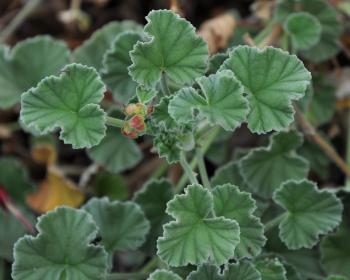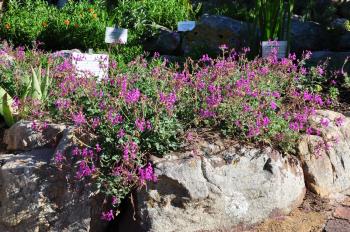Pelargonium reniforme
Pelargonium reniforme Curtis
Family: Geraniaceae
Common names: kidney-leaved pelargonium (Eng.); rooirabas (Afr.); iyeza lesikhali, ikubalo, umsongelo (isiXhosa)
Introduction
Pelargonium reniforme is an attractive showy plant with flower colours varying from pink to magenta.

Description
Description
Pelargonium reniforme is a small, upright perennial shrublet with tuberous roots. It generally attains a height of 300 - 400 mm, but has been known to reach a height of 1 m. In contrast to the soft and downy flowering branches, the short main stem is often covered with the remains of old stipules.

Leaves are reniform (kidney-shaped) or cordate (heart-shaped) with crenate or finely lobed margins and are usually 20 - 30 mm in diameter. Leaves on the main stem are usually larger than those of the flowering stems. The presence of matted hairs give the leaves a velvet-like texture and greyishgreen colour. The lower surface of the leaves presents a thicker hairiness and more distinct venation than the upper surface. Long petioles typify this pelargonium, with awl-shaped stipules found at their bases. Plants flower throughout the year. Flowers are borne in 3- or more-flowered umbel-like inflorescences. Colours vary from pink to magenta with a darker spot and stripes on the upper 2 petals. Six or seven fertile stamens are present.
Conservation Status
Status
There are two subspecies of Pelargonium reniforme : subsp. reniforme is listed as Data Deficient (DDD) and subsp. velutinum is listed as Least Concern (LC) on the Red List of South African plants (Raimondo et al. 2009). A taxon is DDD when there is inadequate information to make an assessment of its risk of extinction. Data Deficient is not a category of threat, however listing of taxa in this category indicates that more information is required and that future research could show that a threatened classification is appropriate. A taxon is Least Concern when it has been evaluated against the five IUCN criteria and does not qualify for the categories Critically Endangered, Endangered, Vulnerable or Near Threatened.
The sale of Pelargonium reniforme by rural inhabitants of the Eastern Cape has become widespread. Unsustainable and unashamed removal of indigenous plants serves only to enrich a few to the detriment of future generations of traditional Eastern Cape peoples. P. reniforme is not at any risk of becoming extinct but is intrinsically linked to soil erosion and insect interaction being minimized through effective management of its populations by conservation authorities.

Distribution and habitat
Distribution description
The kidney-leaved pelargonium is fairly common in the Eastern Cape ranging from Kynsna eastwards to Umtata. The plant grows in fairly dry flats which are subject to intermittent fires.
Derivation of name and historical aspects
History
The genus Pelargonium derives its name from the resemblance of the shape of the fruit to the beak of a stork, pelargos in Greek. The specific epithet reniforme, kidney-shaped in Latin, refers to the form of the leaves. The common names of the plant refer to the leaf shape, and the rooi portion in the Afrikaans common name refers to the colour of the stem. The genus Pelargonium belongs to the family Geraniaceae, a large family of 11 genera and about 800 species in the subtropical and tropical world. There are 270 species of Pelargonium, which occur in S, E and NE Africa, Asia, St Helena, Tristan da Cunha, Madagascar, Australia and New Zealand; 219 species occur in southern Africa. A few Pelargonium species and varieties are still incorrectly referred to as geraniums. Species of the genus Geranium have flowers which are regular in shape, and may be divided into equal halves in any plane, whereas the flowers of pelargoniums can be divided into equal halves in only one plane.
In 1860, Irish botanist William Harvey noted three varieties of species on the basis of leaf and flower colour. The one variety with blackish/purple flowers is now considered a separate species: Pelargonium sidoides, formerly known as Pelargonium sidaefolium.
Ecology
Ecology
The awns on the top of each of the five parts into which the fruit breaks up are usually coiled in a spiral. They enable the parts of the fruit, with the seed they hold, to bore into and secure themselves in the soil if twisted around by the wind or affected by changes in the humidity or the movement of animals.
Uses
Use
Pelargonium reniforme is a medicinal plant known to generations of Khoi/San descendants and Xhosa traditional healers for its health-giving properties in curing stomach ailments, bronchitis, dysentery, blood in stool and the like. Also known as umckaloabo it is traditionally used for a range of therapeutic functions and is well known for its beneficial effect on liver functioning. The medicinally active ingredients are found in the bitter tasting root of the plant.
Growing Pelargonium reniforme
Grow
Like most pelargoniums, the kidney-leaved pelargonium is easy to propagate from cuttings taken at any time of the year. Take stem cuttings from a healthy, vigorously growing plant. To speed up the rooting process, use a rooting hormone. Place the cuttings in a tray filled with river sand and place the tray in a cold frame or in a cool, slightly shaded area. Keep the river sand in the tray moist. The cuttings will root within 4 weeks. Once the cuttings have rooted, pot them into a well-drained, sandy medium and place them in a sunny position. Water the newly potted plants every third day. During their growing period feed with a liquid organic fertilizer on a monthly basis. When they have formed a strong root-ball, plant them in a nice sunny spot in the garden.
Sow seeds in late summer or early autumn, in a light, well-drained seedling mix. Sprinkle the seeds evenly in the seed tray and cover them with fine white sand or fine-milled pine bark. Water the seeds gently but thoroughly with a fine spray and place them in light shade with no direct sun. The seeds will germinate within 4 weeks.
References
- Goldblatt, P. & Manning, J.C. 2000. Cape plants. A conspectus of the Cape flora of South Africa. Strelitzia 9. National Botanical Institute, Pretoria & Missouri Botanical Garden Press, Missouri.
- Raimondo, D., Von Staden, L., Foden, W., Victor, J.E., Helme, N.A., Turner, R.C., Kamundi, D.A. & Manyama, P.A. (eds) 2009. Red List of South African plants. Strelitzia 25. South African National Biodiversity Institute, Pretoria.
- Van der Walt, J.J. 1977. Pelargoniums of southern Africa. Purnell, Cape Town.
- Website: www.plantzafrica.com/plantnop/pelarggross.htm
Credits
Greg Jones & Trevor Adams
Kirstenbosch National Botanical Garden
July 2011
Plant Attributes:
Plant Type: Ground Cover, Perennial, Shrub
SA Distribution: Eastern Cape
Soil type: Sandy, Clay, Loam
Flowering season: Spring, Early Summer, Late Summer, Autumn
PH: Neutral
Flower colour: Purple, Red, Mauve/Lilac
Aspect: Full Sun, Morning Sun (Semi Shade), Afternoon Sun (Semi Shade)
Gardening skill: Easy
Special Features:
Horticultural zones











Rate this article
Article well written and informative
Rate this plant
Is this an interesting plant?
Login to add your Comment
Back to topNot registered yet? Click here to register.